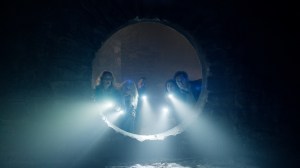In 1922, filmmaker F.W. Murnau unleashed Nosferatu: A Symphony of Horror on audiences, an unauthorized adaptation of Bram Stoker’s Dracula, though a decade later, Bela Lugosi would star in a proper Dracula adaptation. While Nosferatu‘s ghoul was monstrous with his bald head, sunken eyes, and sharp fingers, Lugosi’s count was handsome, seductive, and alluring to both on-screen characters and to audiences. With writer/director Robert Eggers’s Nosferatu, he pulls off the unenviable task of delivering a beast that fuses these archetypes into an entirely singular vision of terror. In some respects, Eggers’s latest serves as the epitome of his career. Nosferatu showcases not only the passion Eggers has for the most seminal experiences in gothic horror, but it manages to blend them in a way that isn’t merely replicating his predecessors, while also somehow injecting fresh elements that were largely overlooked in previous incarnations of the tale.
Videos by ComicBook.com
In hopes of securing a major payday and promotion to improve his and his wife’s lives, Thomas Hutter (Nicholas Hoult) accepts a job that requires him to travel across 19th-century Europe to finalize real estate paperwork with the mysterious Count Orlok (Bill Skarsgård). Thomas’s wife Eleanor (Lily-Rose Depp) protests this, expressing how her love for her newly betrothed is more important than money, though Thomas embarks on his six-week journey anyway. After witnessing the bizarre occult rituals of nearby villagers, Thomas eventually arrives at Orlok’s castle and comes face to face with a confounding and ghastly figure. The commonality between them is their love for Eleanor, only for the woman to start having unexplainable fits of psychosis, with both Thomas and Orlok hoping to put an end to the madness upon a reunion with Eleanor.
Nosferatu touches upon all of the major plot points of virtually every official or unauthorized adaptation of Dracula, as well as every derivation of the narrative. When it comes to reviving dormant properties, there’s a risk of being too beholden to the past and replicating the source material too literally, while there are also inherent challenges when deviating too far from a well-known story. Despite Eggers’s narrative not taking too big of swings that could betray the story that inspired it, this new Nosferatu’s real power is in the unique alchemy of cinematic sensibilities and compelling performances that elevate it above any horror fan’s preconceived notions.
Anyone who’s seen Eggers’s The Witch, The Lighthouse, or The Northman won’t be surprised to see that a gothic horror is the best use of his abilities. Every single frame, every shot, every sequence feels like it could be turned into a baroque painting, as he somehow manages to pay respects to the German expressionist movement, Tod Browning’s 1931 Dracula, and Hammer Films of the ’60s and ’70s, all while injecting his own brand of surrealist storytelling. Some audiences will call these his stylistic decisions derivative, though the approach instead feels like a distillation of more than a century of cinematic interpretations of the living undead.
The biggest tonal deviation Eggers takes from what came before him is the handling of Eleanor, with Depp’s committed performance fully elevating anything that Eggers might have put on the page. Most versions of Eleanor, or any female simulacrum of her, are depicted as an innocent who becomes the target of a frightening figure, due to their undeniably charm. All it took was Eggers offering up an opening scene with Eleanor that completely changed her role in the story.
Before audiences even know that Count Orlok exists, Eggers teases in an opening scene that there’s a darkness within Eleanor that has been with her for years. Neither the filmmaker nor Depp ever exactly confirms what that darkness is, and it’s that ambiguity that makes Eleanor such a layered and tragic figure. Whether a viewer infers that Eleanor suffers from depression, feels shame over sexual desires, or has endured countless other types of malady, Eleanor feels ostracized by her community, societal norms, and those closest to her, causing her to call out into the unknown darkness for any respite from this otherness. Tragically, it’s Orlok who has answered the call, serving as the manifestation of any seemingly nefarious entity plaguing one’s life. Depp manages to not only depict these many layers of emotional conflict and torment, as surface-level as missing her husband to the emotional torment of betraying morality, but also has the opportunity to bring a frenetic physicality to Eleanor’s more frantic moments. As seemingly meek as Eleanor is through most of the film, one confession with Thomas later in the story takes Depp’s performance to an entirely new level. Depp’s performance and Eggers’s script transform the story into something far more romantic and far more empathetic, feeling both timeless and entirely modern.
Ever since audiences knew that Skarsgård would be playing the iconic monster, they wanted to know how he would physically embrace the role. Eggers and the marketing materials have made it a point to keep the beast shrouded in secrecy, though we can safely say that this Nosferatu‘s Orlok is not what you’re expecting. Anticipation should be tempered to some degree, as this Orlok might not change everything you know about vampires, but that isn’t to say that the physical transformation Skarsgård undergoes isn’t really like anything we’ve seen before. Much like how Eggers tonally honors Max Schreck’s Orlok from 1922 but also Lugosi’s Dracula, Skarsgård similarly borrows a number of influences so that his Orlok is frightening, alluring, sophisticated, and monstrous all at once. Skarsgård intimidates the characters and elevates the omnipresent influence of Orlok not solely through his physicality, but the actor also mutates his voice into a chilling register that we can feel in our bones.
Depp and Skarsgård are the standouts of the picture, but supporting actors Hoult, Willem Dafoe, Aaron Taylor-Johnson, Emma Corrin, Simon McBurney, and Ralph Ineson also help carry the gravitas of the endeavor. In any other project, the supporting stars would earn the majority of accolades, with it being a testament to how captivating Depp and Skarsgård are that the supporting cast’s complex portrayals feel at all overshadowed. (As expected, though, witnessing Dafoe as a Van Helsing-esque scholar obsessed with cats and the occult is as delightful as one could imagine.)
Eggers broke onto the scene with his movie The Witch, and while some horror audiences were expecting all manner of witch-related mayhem, that movie was a period-specific exercise in paranoia. The filmmaker’s devotion to authenticity makes Nosferatu the perfect showcase for those priorities, as he immerses audiences in everything from snow-covered forests to rat-infested city streets to cavernous castles. These settings and environments feel all the more rich thanks to the movie’s score, sound design, and cinematography, only for the realism to be perverted when Eggers leans into the more surreal elements of the concept. Whether it be the shadowy, outstretched hands overcoming an entire city or a ghastly silhouette billowing behind a curtain, the realism of much of the film makes these moments feel all the more unsettling. Eggers even manages to channel the spirit of Murnau’s seminal experience without merely replicating him. One of the most iconic visuals of the original movie, for example, is the silhouette of Orlok ascending a staircase despite audiences not seeing his corporeal form, and while Eggers finds a way to channel the spirit of that sequence, it’s done in a way that’s unexpected and effective.
Eggers has been vocal about his desire to make his version of Nosferatu for more than a decade, only for his earlier attempts to see setbacks that required him to pivot to other projects. Those obstacles would understandably be frustrating for both the filmmaker and for his fans, but the final product has proven to be the pinnacle of all of his talents, as his previous exploits allowed him to hone his craft and learn the importance of restraint. Anyone who has even a passing familiarity with Eggers’ work could have predicted that his Nosferatu would be visually striking and tonally sophisticated, all while being both romantic and terrifying, but it’s Depp’s enthralling performance and Skarsgård’s nightmarish metamorphosis into Orlok that makes this not only Eggers’s masterpiece, it also serves as a seminal interpretation of a century-old text that will be the defining gothic horror for a generation of filmgoers.
Rating: 5 out of 5
Nosferatu will land in theaters on December 25th.








